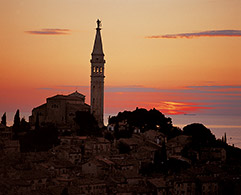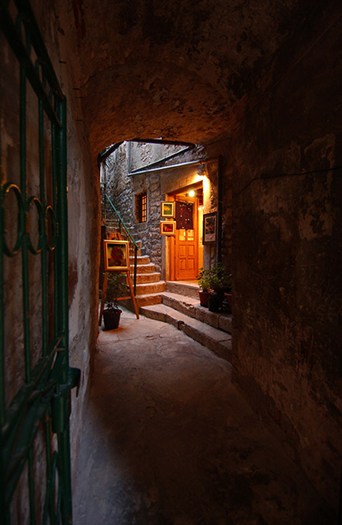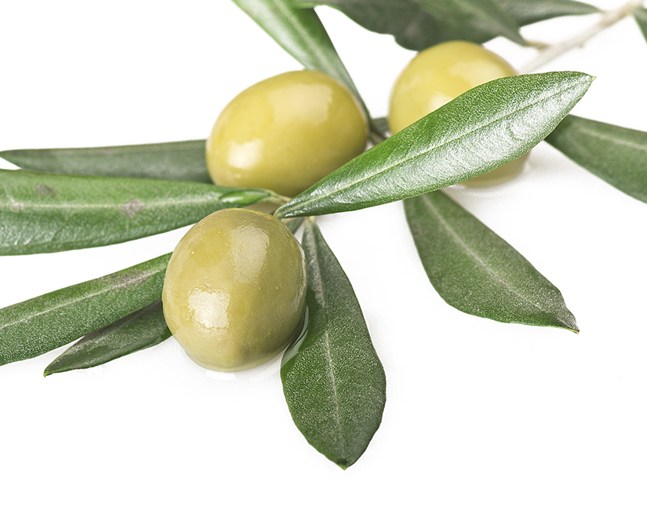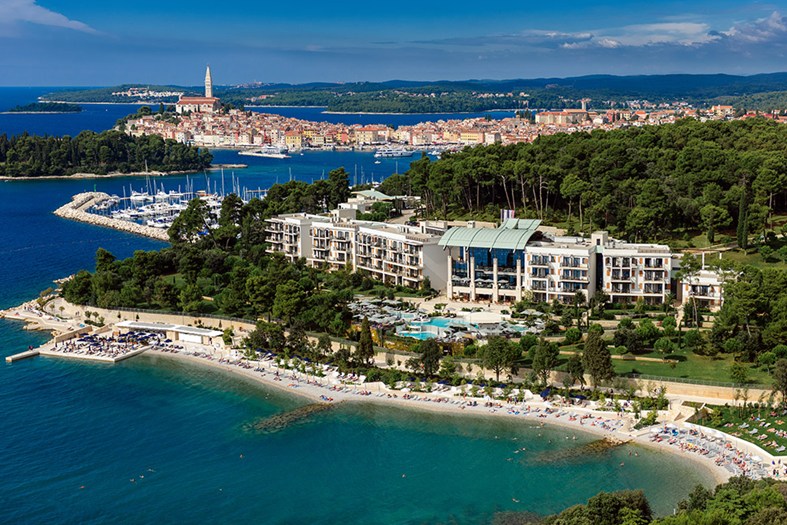ROVINJ, CROATIA - I’ve sipped many shots in life, including, I must admit, some I don’t remember, but not until I visit Croatia’s Istrian peninsula do I take my first shot of olive oil. It’s only appropriate, as olive oil is as revered here as wine.
I’m spending the afternoon at Chiavalon, a family-owned olive oil producer with 7,500 olive trees on its property (and several thousand more it manages elsewhere) whose Ex Albis oil was named one of the world’s 15 best. Several of us are seated in an elegant tasting room where dozens of bottles, filled to varying degrees with olive oil decorate the walls, and a fireplace warms us. Here, we’re getting a lesson in olive oil tasting from one of the owners, Tedi Chiavalon, who reveals a sobering stat: “Around 80 per cent of all olive oil on the world market isn’t really extra-virgin olive oil,” he says.
In other words, that oil you’re spending a fortune on at the grocery store could be little more than a cheap impostor.


Left: The Old Town of Rovinji is perched on a hill. Right: It's narrow streets are a great place to wander.
That makes me even more determined to learn how to spot a quality olive oil, hence the shot I’m about to take, which arrives in a small glass. I sniff it first, locking in the earthy smell (it should be somewhat earthy, fresh and possibly fruity but never sweet) and then seal the glass with my right hand while warming the underside of it with my left. Finally, I take a sip, swishing the oil so it coats my mouth before puffing my lips open slightly to give it some oxygen.
The sensation in my mouth is bitter, but as I swig the oil, the surprising spiciness makes my eyes water and sends me into a coughing fit, thanks to the oil’s polyphenols. And that, my friends, is how you know you’ve just sipped an exceptional olive oil.
If the olive oil makes this area seem more Italian than Croatian, that’s because it is. I’m almost 1,000 kilometres from cosmopolitan Dubrovnik, after all. Rovinj, the fishing village of about 14,000 residents where I’m staying, lies about two hours via car from Venice along the shores of the Adriatic Sea, which olive trees love.
So, too, apparently do vineyards, for they’re as prominent as olive trees. The majority of families in Rovinj, in fact, have olive trees and vineyards in their backyard and make their own table wine, some of which they sell roadside during summer, often quenching the thirst of cyclists riding past.
Wine is such a staple here that the locals even drink it for breakfast, which explains why I see it on the breakfast buffet at the Hotel Monte Malini where I’m slumbering.
“We view wine as food,” says my tour guide Maslinka, explaining that in the days of old — the city dates to 7th century AD — the water was so bad that people mixed red wine into it so the alcohol would kill the bacteria. Today, this area produces about equal amounts of red and white wines.
It doesn’t only taste like I’ve crossed into Italy, it also looks and smells like Italy. From my hotel, which sits on the Zlatni rt Park Forest, where I later find small beaches and recreational trails, I walk along the Adriatic Sea into Old Town. Along the way, I pass scores of batanas, Rovinj’s small wooden boats, and when I reach the city’s historic centre, I see street signs written in Croatian and Italian, proving that this is indeed a bilingual city. Locals, in fact, speak both languages.
I wander further into Rovinj on its narrow, winding cobblestone streets, where I find upscale boutiques, jewellry shops and art galleries. Old Town, which juts out from a peninsula like an orphaned thumb, is angled downward to the sea, upward toward its iconic 18th-century baroque church, St. Euphemia, and at times, the slope in the streets is brutal. (The remains of Rovinj’s patron saint are rumoured to be buried here.) I climb to the top of the church — the tiny rickety stairs turn this into an adventure — where I’m rewarded with 360-degree views of Rovinj, red-roofed buildings dotting the landscape.
Had I hawk-eye vision, I would have tried to count the pizzerias and gelaterias I spot, a number I’m guessing rivals Rome. Perhaps a slight exaggeration but suffice to say Italian fare is plentiful here. I’m dizzy with the rich tomato smells wafting from these restaurants, all of which are overflowing with boisterous diners. Ditto for the street side cafes and restaurants where al fresco dining is the norm.
“The outdoors is our living room,” says Maslinka, adding that when getting together with friends and family, locals prefer to be outside.
So I feel lucky when I slip into a spot at a long wooden table at Kantinon. With its high vaulted ceilings and massive wine vats, the restaurant is more like a wine cellar than eatery. Ironically, I forego the wine and ask for a pivo. I’m served the local favourite, a San Servolo, a tasty, easy-sipping beer. It washes down well with a piece of crusty bread, which I’ve dunked in olive oil and sea salt, the main table condiments here. As they say in Italy, I mean Croatia, molto buona.
Turns out, wine and olive oil aren’t the area’s only culinary treasures. So, too, are truffles, as Istria is famous for these mushrooms. About an hour north of Rovinj in Livade is Restaurant Zigante, whose owner, Giancarlo Zigante, captured a Guinness World Record (which he still holds) when he found the world’s largest truffle, a whopping 1,310 kilograms.
Here, I’m whisked to a forest nearby where I change into knee-high green boots and meet one of roughly 1,500 truffle hunters in Istria. A licensed guide is a must when hunting for truffles, otherwise, you could face severe fines. Alongside him are two female dogs, neither of which I’m allowed to pet.


Left: Olive oil is the big business in this town. Right: Lovely coastline draws a lot of tourists to the area as well.
Soon, the dogs, already chomping at the bit to go, are released and they race through the woods on their quest for black truffles, which can be found year-round. White truffles are the more prized, as they draw the most money — up to $3,500 (U.S.) a kilogram — but they’re only in season from September through January and I’m about two weeks too early.
The truffles lie about 10 to 30 centimetres below ground, and the dogs use their powerful sniffers to locate them. The scent of a truffle can linger two to three hours after being unearthed so there are several false finds. But once the dogs find a truffle — they locate four in about 45 minutes — they dig ferociously until the hunter calls them away.
I ask about their training, which starts in puppyhood, but the hunter shakes his head. At first, I suspect he hasn’t understood me. But I later learn that hunters guard their training techniques closely. They used to hunt with pigs, by the way, until the pigs began destroying the forests too much.
Truthfully, I return to Zigante with little appetite for fungus, especially after seeing how they look like petrified balls of poop (and smell just as bad). But my opinion changes when I sit down for a four-course meal at the restaurant that features an Istrian truffle-based menu. It’s the tagliatelle that seals the deal for me.
It looks simply like noodles in a bowl until my waiter grates a black truffle over the pasta. I’ve just entered fungus heaven. Anybody know how to ask for seconds in Italian — or Croatian?
Information
How to get here: Fly into Pula, about 40 kilometres from Rovinj, or easier-to-reach cities like Venice (about 250 km away) where your connecting option is car or ferry. / Where to stay: Indulge in luxurious accommodations at Hotel Monte Mulini (
www.montemulinihotel.com) or its more chic sister property, Hotel Lone (
www.lonehotel.com). The beachfront properties are situated side-by-side, and both feature spas. Lone also has an impressive wellness centre with gym, saunas, Turkish bath, indoor swimming pools and a relaxation garden; Mulini guests have full access to this. If you prefer to stay in the heart of Old Town, veer toward the newly opened Boutique Hotel Adriatic (
www.maistra.com/adriatic_rovinj). / Where to eat: At Monte Mulini’s Wine Vault, book the Chef’s Table, and the chef will create a customized menu of several courses. You’ll then dine in a funky room where the white walls are adorned with art and phrases scribbled by guests. At Hotel Lone, head to Restaurant L for creations that rotate regularly and meet the needs of various diets, including vegetarians. In the city, book reservations around sunset at Ristorante Lanterna, a castle which requires a short ferry ride to reach. Or head to Bale, a small village near Rovinj, for dinner at Meneghetti Restaurant, where you’ll enjoy exquisite local culinary creations, each paired with Meneghetti’s own wines and olive oils.
About the Author
Karen Asp is a health-conscious travel junkie who counts Paris, Chicago, Barcelona, and Jackson Hole, Wyo., among her favourite places. She loves travelling anywhere that adventure – whether physical or cultural – abounds. Some of her most memorable experiences were: Swimming with penguins in the Galapagos; hiking the Inca Trail into Machu Picchu; logging two 10Ks on two different continents (Australia and North America) on the same day, and tandem paragliding in Jackson Hole. Along with being an avid craft brew and gelato fan, she holds five world records in Nordic walking and a full-time career as a journalist. She’s a contributing editor for Woman’s Day and writes for numerous other leading publications, including Islands, More, O, SELF, Health, Parade, Prevention, Better Homes and Gardens, Real Simple, Travelife, Shape and Martha Stewart Living.